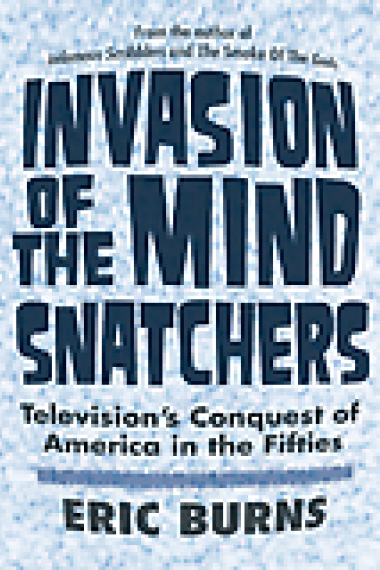Eric Burns’s lapel-grabbing title does his book a disservice. The invocation of a 1956 sci-fi movie that made people wary of watermelons is at odds with his more sober judgments about how the new medium changed the country. Television did not turn us into zombies: “What we Americans learned to do as the fifties progressed was incorporate television into our lives rather than allow our lives to be controlled by it. The medium became a choice rather than a czar.”
Not much to argue with there, even for those of us who watched test patterns on off-the-air channels during the late ’40s and early ’50s. The wonder of the motionless patterns identifying the idle channels was that they existed at all, grayish and humming, right there in our living rooms. Though the technology had been around for decades, TV sets did not become household items till the postwar ’40s. With remarkable speed, television then moved from marginal to mainstream.
The first half of Burns’s history is a scattershot survey of television’s encroachment on American life, a process that altered everything from where and when we ate dinner to how we picked our toothpastes and our presidents. He hopscotches his way across the decade, landing on an interesting trend here (television had a calming effect on persistent viewers) and an alarming one there (“the fifties were a time of frivolity . . . fads ruled”). Hula-Hoops, Pez dispensers, pedal pushers, and ponytails, he argues, distracted us from serious thought—as if a Hula-Hooper would otherwise have been reading Hegel. A Davy Crockett coonskin cap has for Burns the temporal pull of a Proustian cookie, and the audience most likely to appreciate the cascading detail in his narrative are grownups of his own advanced baby-boomer age willing to be pulled back with him to the analog America of their childhoods.
Burns, author of five other books, grants the ’50s a Blob–like expansiveness; the decade seeps forward, backward, and sideways. Narrative discipline and chronology are not his strong suits, and as sociologist and cultural critic he repeatedly invites interruption. What does it mean, for example, to call the ’50s “a uniquely vexing and eclectic decade”? More vexing than the ’30s, or ’60s, or now? He thinks that the ’50s were “a fulcrum that tipped from yesterday to tomorrow,” and then makes that fulcrum do somersaults, taking us from Graham Greene’s novel The Heart of the Matter (1948) to the rock musical Hair (1967).
In the second, and more coherent, half of the book, Burns revisits the effects television had on politics, religion, and the movements for civil and women’s rights. He gets to recall a cast of marvelous midcentury characters, including Senators Kefauver (crime fighter) and McCarthy (alarmist); avuncular, calculating Ike; Dick Nixon on offense and defense, Pat Nixon in her respectable Republican cloth coat, and Checkers the family dog; Amos, Andy, and, uh-oh, the politically incorrect Kingfish; über-Catholic Fulton Sheen and entrepreneurial evangelist Oral Roberts; quiz show cheater Charles Van Doren; and brave black students kept from their classrooms and threatened with violence. All found their televised way to America’s homes, and the nation was riveted. Burns’s lively retrospective glides smoothly through their stories, at about the depth of a standard TV documentary. Eric Burns is not Ken Burns, and that’s all to the good; the reader stays awake for the duration.
“Television was nothing when the fifties started, everything when they ended,” writes the sober Burns, who immediately turns into the suspect sociologist: “But with time and circumstance Americans had lost not only their initial enthusiasm for the medium; we had lost our belief in its veracity and good intentions, and for most of us, neither quality would be fully restored.” That’s a statement as worthy of a place in the serious annals of mass disenchantment as the curtain pull on the Wizard of Oz.
Within a few years of its primitive beginnings, commercial television had headed down paths of evolution and devolution that it travels to this day. The basic programming genres were set—drama, comedy, politics, news, sports, games, even competitive humiliation (Strike It Rich, Queen for a Day). Ahead lay proliferation, refinement, coarsening, and endlessly burgeoning fallout. This past summer, the sitting president of the United States sat within the estrogen-laced precincts of ABC’s The View, the coffee klatch as art form. The president did so willingly and could not, for once, blame his predecessor. He was merely catching a cultural wave that began as a ripple in Burns’s distant ’50s, has gathered force ever since, and shows no signs of breaking. Not even on the Jersey Shore.

